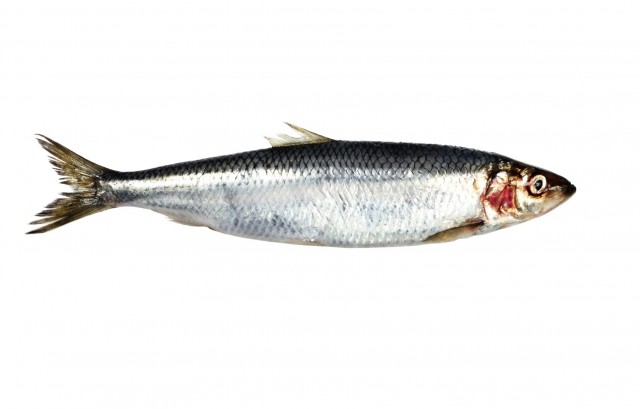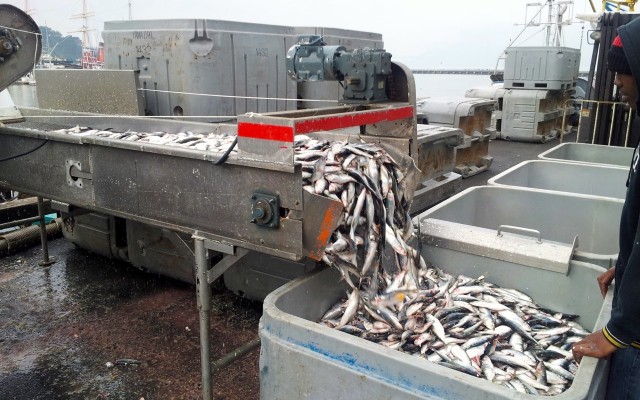
The San Francisco Bay is a frenzy of rapturous seagulls, cormorants so gorged they can barely take flight, sea lions bellowing and porpoises?spinning.
The herring have returned to?spawn.
Humans are getting in on the action, too. A herring festival last weekend in Sausalito offered tastings of various preparations, and chefs all around the Bay Area are serving the omega-3-rich fish in a smorgasbord of dishes, with the catch expected to remain plentiful into?March.
In San Francisco, Bar Tartine has offered the fish creamed on sprouted rye, and Rich Table has served it pickled over Douglas fir levain with honey and buckwheat. Waterbar makes a warm local herring salad with potato puree and citrus, and Delfina combines the fish with citrus after curing?it.
Smoked and?pickled
Curtis DiFede, co-owner and chef at Oenotri Restaurant in Napa, says the house smoked and pickled herring is one of the most popular items on the?menu.
"We use local herring to educate ourselves and our customers about the bay. Our local herring is not as fatty as from the North Pacific. It's more mild and lean, and really?delicious."
Paul Canales, co-owner and chef at Duende, preserves herring eggs in salt to make a bottarga and serves it over a crudo of white sea bass. Says Canales, "Herring is so versatile. You can pickle it, smoke it, cook it fresh and use the roe. There's a short season, so it's a celebration of the bounty happening right?now."
Local herring on menus is fairly new. The fish were popular during the Gold Rush, and consumption peaked during World War I when they were canned. New immigrants fished them for subsistence until the 1950s, but after that the fish went largely?ignored.
In 1972, California herring fishing got a major boost when the Russians banned the Japanese from an important herring?ground.
Japanese traditionally eat herring roe, or kazunoko, at the start of a new year because it symbolizes prosperity. The Japanese turned to the United States, setting off a "silver rush" in San Francisco and Tomales bays and leading to fishing limits in 1973. Since then, local herring has been harvested mostly for its high-priced roe, with the rest made into fertilizer and fish meal fed to pigs, chickens, pets and farmed?fish.
About four years ago, however, the fishery collapsed. As The Chronicle's Peter Fimrite reported on Jan. 24, warm water and lack of food caused a catastrophic population decline and, in 2009, forced the state to close the?season.
So the return of the herring run is cause for celebration – and offers a chance to help save the fish by eating?them.
Environmental scientists say that instead of feeding herring (and other "forage fish," such as sardines and anchovies) to farmed fish in the form of fish meal, we should eat them?ourselves.

Herring, caught in San Francisco Bay, are usually turned into fish meal and fed to farmed fish. But in the Bay Area, restaurants are serving up the small fish–a dining choice that scientists say could help save the species. Photo by Martin Reed.
To produce 1 pound of farmed salmon, it takes 3 pounds of wild forage fish, and 1 pound of ranched tuna can take 15 pounds of forage fish to produce. Scientists like?Geoff Shester?of the nonprofit group Oceana argue that eating these small fish, which have short life spans and reproduce quickly, is more environmentally friendly than eating carnivorous farmed fish or large fish that breed later in life, like swordfish and?tuna.
Says Shester, "We'd be using more of the fish (not just the roe), and it would be a higher-value product, which ultimately would benefit our local herring?fishermen."
"Everything from humpback whales to crabs rely on these, so we monitor (the herring) closely," says?Thomas Greiner, environmental scientist for the?California Department?of Fish and?Wildlife.
This year, the catch quota is 4.7 percent of the total bay population – a number, says Greiner, that is "conservative and?sustainable."
Bay Area chefs believe that if we eat what comes from the bay, it makes us more aware of its health. "When that oil tanker hit the Bay Bridge in January, herring was the first thing I thought of," says?Douglas Bernstein, chef at Fish Restaurant in?Sausalito.
Bernstein lived in Denmark, a herring-loving country, where he developed a taste for the fish. "We ate it for breakfast most mornings. Here, people just aren't used to?it."
But that's changing, he says. At Fish's retail market, the staff hands out samples of their pickled and smoked herring, both of which quickly sell out. "Pickling and smoking stretches out the season," Bernstein?says.
Fish Restaurant, among many others, participated in the inaugural Sausalito Herring Festival on Feb. 9. Along with herring tastings, there were filleting and smoking demonstrations, and biologists were on hand to talk about the natural history of the?fish.
Steady supply is?tricky
Both TwoXSea in Sausalito and?Monterey?Fish sell herring to stores and restaurants, but because the fish arrive in such enormous schools and for such a short season, getting a steady supply can be?tricky.
Still, several Bay Area retailers are carrying fresh herring, including Monterey Fish and Tokyo Fish in Berkeley; Bi-Rite Market and Avedano's in San Francisco; Fish in Sausalito; and Crystal Springs Fish and Poultry in San Mateo. Prices range from $2.95 to $5 per?pound.
Bi-Rite and Fish also sell their own house-pickled herring, and Fish sells its house-smoked herring. As with any fish, it's best to call ahead to ensure?availability.
Herring is also one fish that aficionados can catch themselves. One way to learn how to do this is by taking a Sea Forager tour with Kirk Lombard.
During herring season, he has an e-mail system set up to tell groups where to meet him to see schools of?herring.
"The herring are abundant and easy to catch," he says. "It's so life-affirming to be out there among the animals. And if you catch a fish yourself, it always tastes?better."
This story was originally published by the San Francisco Chronicle





